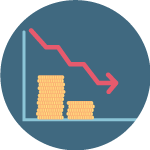8763f483-74c1-4ae2-a7d0-2f7da508c0ee
The global economy has been hit by a series of challenges in 2022: Russia's invasion of Ukraine, towering inflation, rate hikes and Covid-19 lockdowns in China. The challenges have put pressure on global growth, and Danske Bank's analysts now expect the pressure to rise.
“Not all regions of the world experience the same headwinds as they are driven by different undercurrents, but what they have in common is that they are putting pressure on consumers and businesses,” says Aila Mihr, Senior Analyst at Danske Bank and one of the analysts behind the outlook.
The perfect storm in Europe
The euro area is facing the perfect storm and will likely be the first region to slip into recession this winter. Delayed effects from the ECB’s monetary tightening and fading foreign demand as well as the ongoing energy crisis are setting the scene for an economic slowdown that will last for some time.
“A crisis is not only a challenge, but also an opportunity. Countries like Germany are stepping up investments in infrastructure, digitalisation and the green transition, which presents a silver lining to the growth outlook, and not least an interesting business opportunity for Nordic companies offering solutions in these areas,” says Aila.





.png?h=814&iar=0&w=1024&rev=68142722156e4ef6911feaea78e47d78&hash=2547C42024425542B4E65EA5FC477300)
.png?h=128&iar=0&w=128&rev=c0456076148343a69ec27218e9fa39aa&hash=5367D3AD7CFBE8E78181A6587FAB2790)